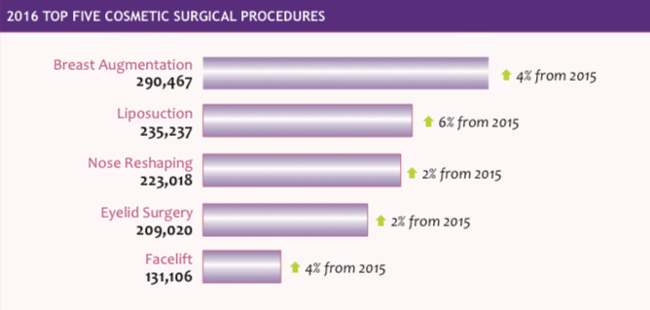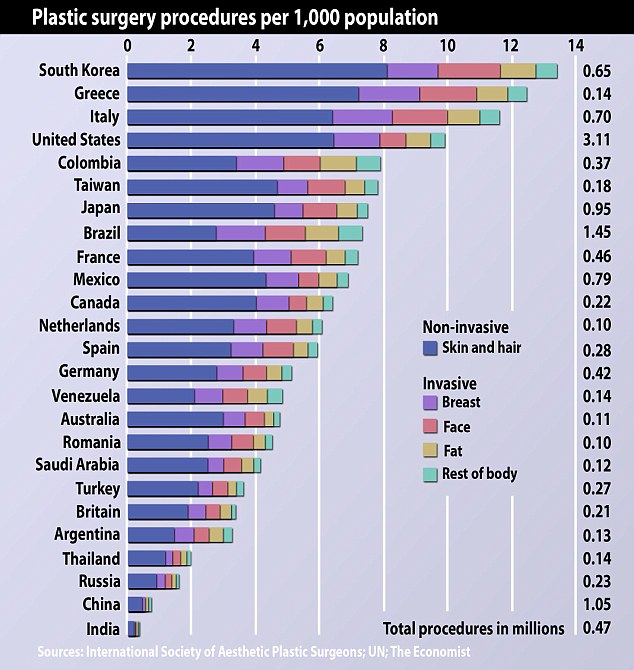
Experience shapes training into even better results. Ask your Board Certified Plastic Surgeon about their experience.
It is important to have all the information before deciding on a Cosmetic Plastic Surgery procedure. This post reviews question two of the five questions you should always ask before having Elective Cosmetic Surgery. The five questions are:
- What Is Your Training?
- How Often Do You Perform The Procedure?
- How Is The Procedure Performed?
- What Is The Recovery Like?
- What Is The Total Cost?
How Often Do You Perform The Procedure?
How often do you perform the procedure? This question gets to your surgeon’s experience. Excellent Training is a must and was reviewed in the previous post. What happens after training is equally important. You want a Cosmetic Surgeon who actively practices the procedure they are doing for you. Someone who has the skills and good judgement, specific to your needs.
Last year, almost two-million cosmetic plastic surgery procedure were performed by eight-thousand US based Board Certified Plastic Surgeons. This is an average of 225 operations per surgeon. This is a good number to have in mind when we are evaluating how many times a surgeon performs a certain procedure each year. Some surgeons do 100 operations a year, some do 500. Some surgeons operate fast than others. Some work three days a week, some work six. Specialists will do a higher percentage of a certain procedure, and necessarily fewer other procedures.
How To Measure Experience
Quantity and quality do not always correlate. There is a quantity with above which quality suffers. There are also some very busy, below average ability surgeons. They may have slick advertising campaigns. They may always be offering the absolute latest technology. They may provide cut-rate surgery costs. Unfortunately, often by corners are being cut behind the curtain. Buyer beware.
Two simple ways to measure experience are years in practice and a clean record with the medical board. Both are easily checked online, and these should always be checked. For your convenience, I have links for checking Board Certification and standing with the California Medical Board at the bottom of the San Francisco Plastic Surgery Blog’s American Board of Plastic Surgery Page.
How Many Procedures Are Enough?
How often your plastic surgeon does a particular procedure is a gauge of experience. But, how many procedures are enough? The answer varies.

Surgical statistics for each year are available on the ASPS and ASAPS web sites. Knowing how common a procedure is will help you determine how many procedures a year are reasonable.
Numbers go up depending on the popularity safety and reliability of the procedure, and there is regional variation. On the other hand, Plastic Surgeons with more skills, better judgement and more experience will require lower numbers to maintain their skills. If a surgeons only does a certain procedure, you should expect them to do a larger volume of that procedure. Unfortunately, there is no guarantee that a surgeon is better, just because they do, or claims to do, more procedures. Numbers are just one way to measure experience, but in general, more is better.
Procedure Popularity
Some procedures are more popular than others, so higher numbers are expected for procedures like Breast Augmentation and Liposuction, and lower numbers are expected for less common procedures like Buccal Fat Pad Reduction and Lower Body Lifts. Dividing the number of procedures performed in the US by the number of plastic surgeons in the US gives us a rough average for each procedure. By the nature of an average, half the plastic surgeons in the US will do less than the average number of procedures. This does not necessarily mean they are worse at it.
Here is an example. If 300,000 Breast Augmentations are performed in one year, and there are 8000 Plastic Surgeons in the US, the average is 300,000 divided by 8,000 or 37 Breast Augmentations per Plastic Surgeon. In other words, the average US Plastic Surgeon would be expected to do about 37 Breast Augmentations a year or about three a month.
Breast Augmentation is often the most frequently performed Cosmetic Plastic Surgery procedure performed in the US. Other very popular procedures include: Eyelid Surgery, Liposuction and Nose Reshaping. Each of these are performed approximately 200,000 times a year or twice a month for the average Plastic Surgeon.
Facelifts, Tummy Tucks and Breast Lifts are at a frequency of 100,000 a year or a once a month average. Gynecomastia Reduction (Male Breast Reduction) is performed about 25,000 times a year in the US, or 3 operations a year for the average Plastic Surgeon. Arm Lifts have a lower frequency. Fewer than 18,000 Arm Lifts are performed each year, which works out to two a year on average. Thigh Lifts are performed even less frequently, so the average is about one a year. Buccal Fat Pad Reduction is even less common. It’s all relative.
Some Procedures Work Better Than Others
Some procedures work better than others. These tend not to be the latest and greatest procedures. The most reliable procedures are tried and true and tend to be mainstream general plastic surgery procedures. Surgeons with good judgement will do more of these general plastic surgery procedures and fewer very specialized niche procedures. You should expect your surgeon to do more “full” procedures than “mini” procedures. I prefer using the smallest hammer that will get the job done; however, mini procedures do less. To get a good result from a mini procedure, you need to have a mini problem. If your surgeon is only doing mini procedures, this is a red flag.
When Is The Last Time You Did This Procedure?
The question, “How often do you perform a procedure?”, is really two questions in one. “How many procedures do you do?” and “How recently have performed the procedure?” Two questions which combine to give insight into how familiar your plastic surgeon is with your procedure. Someone who has done 50 procedures ten years ago, may not be as qualified as someone who performed 50 procedures in the last year. So you might want to ask a follow-up question about the last time your surgeon performed the procedure you are interested in.
The Shape Of The Practice

The popularity of Cosmetic Surgery varies by country. While South Korea, Greece and Italy beat the US by surgeries per capita, the column to the far right shows that no country does more Cosmetic Surgery than the US.
As practices are busier, the number of procedures performed goes up. Hopefully, they are busier because they are doing a better job. Additionally, as surgeons specialize, they limit the number of other procedures they perform. Moreover, they should be expected to be doing more procedure in their area of specialization.
Specialists
Specialization is good. It allows a surgeon to focus on a particular area of interest. I am Board Certified in General Surgery and Plastic Surgery. I am trained in many procedures, but I choose to specialize in Cosmetic Plastic Surgery. The majority of my practice is Cosmetic Plastic Surgery. I had excellent training, but I have learned more in my 20 plus years of practice than I learned during my many years of training. Moreover, being a Cosmetic Plastic Surgeon was a goal I set before beginning my training. This goal shaped the entire course of my training as well as the types of procedures I perform on a daily basis.
Super-Specialists
There is an expression which goes: When all you have is a hammer, the entire world looks like a nail. Be a little cautious of super-specialists. Most good super-specialists are well rounded surgeons who still do other procedures. On the other hand, there are some super-specialists who have only learned one way to do a procedure. They may lack the training, experience or ability to offer you alternatives that may actually work better.
The Life-style Lift company is a good example. The company specialized in facial rejuvenation. They promised a bargain basement, one hour fix, under local anesthesia, with minimal downtime. Essentially, they did a mini-facelift on everyone they met. Unfortunately, the downside to this one-size-fits-all solution was not explained. Risks were minimized and outcomes not maximized. They even employed Debbie Boone as their cheerful spokeswoman. She promised a low cost, low downtime solution wrapped in slick advertising and misleading before and after pictures. The company had many complaints, many lawsuits and was fined by multiple states for false advertising and unethical behavior. Lifestyle Lift is now bankrupt, but not before giving many patients, and plastic surgery, a black-eye.
The Only One
Be even more cautious of experts claiming to be the only one performing a certain procedure. Good procedures are like wildfires; they spread quickly. Fat grafting to the Buttocks, better known as the Brazilian Butt Lift, was unheard of in the US in 2000. It has been the fastest growing procedure for several years running. The number of Brazilian Butt Lifts performed increased from 3000 to 30000 procedures per year over the last five years. It has expanded quickly because it solves a problem better than the previous operations. It is by no means a perfect operation, but it is a good operation, that works better than the alternatives (Buttocks Implants). When something works better, word spreads quickly.
Good procedures are very unlikely to remain in the hands of a single surgeon. Most plastic surgeons share their good ideas at our annual meetings. This is done not for personal financial gain, but for the good of the profession. The American Society of Plastic Surgeons (ASPS) and the American Society for Aesthetic Plastic Surgery (ASAPS) have both stated that trying to patent or restrict the distribution of a medical procedure is unethical and grounds for expulsion. Sharing is caring, even for medical professionals.
Cross-over Procedures
Many plastic surgery procedures are similar. In some ways, Tummy Tucks, Arm Lifts and Thigh Lifts are the same procedure. The require similar skill set. This means there is some cross-over experience between these three procedures. What I learn through experience with common procedures, like Tummy Tucks, can help me achieve better results with less common procedures, like Arm Lifts and visa versa.
There Is No Magic Number
While a greater number of cases implies more experience, there is no number that can absolutely guarantee your results. Some people learn faster than others. This is true for doctors, too, so the number of repetitions needed to be safe and effective with a procedure will vary from doctor to doctor. Good training should make a surgeon safe, while experience makes them more effective. You want to choose a Cosmetic Surgeon who is both qualified and experienced.
We are fortunate. The San Francisco Bay Area is home to some of the best plastic surgery training centers in the world. We have many qualified and experienced Board Certified Plastic Surgeons to choose from. If you are interested in any of the procedures mentioned above, or elsewhere on the San Francisco Plastic Surgery Blog, call (925) 943-6353 today, and schedule a private consultation appointment to learn more.
Previous Post Next Post